.jpg)
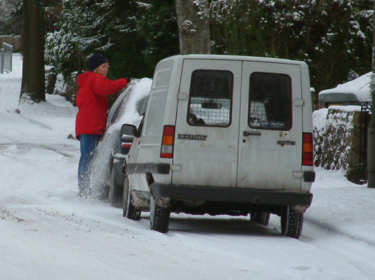 Eskimos live with snow for a lifetime, but many people reading this will only see real snow for a couple of days each year - or less.
Eskimos live with snow for a lifetime, but many people reading this will only see real snow for a couple of days each year - or less.
Despite the tail slide you luckily recovered from back in 2008, you are not an expert!
Getting ready for winter is essential for all drivers, especially salespeople and others who depend on driving to earn a living.
Whether on a long journey or driving down the road to work, being prepared for the problems that arise in winter weather will prevent them from becoming disasters.
We seem to have one or two days of 'sudden' cold weather every year in the UK – although our winters have been warmer in recent years, the bad weather is more extreme when it hits, leaving many drivers stranded. Sadly, some drivers have died from hypothermia after getting stuck in remote locations.
The authorities could do more, but the starting point for winter safety is looking after yourself (and those around you!).
Whilst road deaths directly attributable to bad weather may be relatively rare, winter snow, ice, rain and fog can cause significant inconvenience and be expensive.
This section looks at the main things you need to know to stay safe.
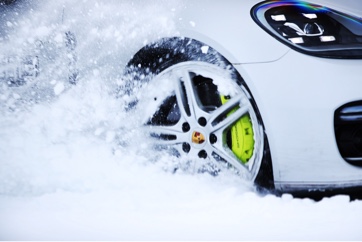 Data from Admiral Car Insurance in 2020 revealed that more severe road traffic accidents happen in winter due to many motorists being unprepared for winter weather and ignoring weather warnings.
Data from Admiral Car Insurance in 2020 revealed that more severe road traffic accidents happen in winter due to many motorists being unprepared for winter weather and ignoring weather warnings.
The information in this section is an excellent way to improve your winter driving knowledge and technique – and reduce your risk when the weather hits.
If you want to really 'go for it' and have enough cash for a holiday, visit a northern European 'snow school'. Alternatively, a car handling control course, typically done on a skid pan or in a specially adapted vehicle, could do a lot to help you stay on the road in winter.
But to start with, the best advice for winter motoring is probably to stay at home!
If you must go out, check the weather forecast, ensure that you fully prepare for whatever you might encounter, and familiarise yourself with our advice.
 If you have to make a long journey in poor weather, take a break more often than you usually would. The extra concentration needed will make you tired more quickly.
If you have to make a long journey in poor weather, take a break more often than you usually would. The extra concentration needed will make you tired more quickly.
Not only do you want to arrive alive, but if you are driving as part of your work, you also want to arrive in a fit mental state to do business.
Start long journeys with a check on the weather conditions and forecasts. Roads can become impassable very quickly in high or exposed areas (such as crossing mountains or wide plains).
Use your sat-nav to plan a route that sticks to main roads wherever possible. These roads are more likely to be clear and gritted. If you drive an electric vehicle, they will also be more likely to maximise your range with less stop-start driving.
Also, ensure that you have an 'emergency kit', just in case things don't go to plan.
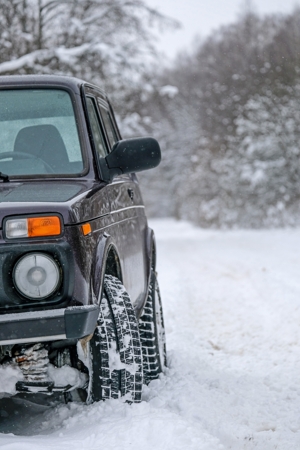 Good vehicle control is always important – but it becomes critical when driving on snow and ice. The key to good control lies in the sensitive use of the pedals and steering.
Good vehicle control is always important – but it becomes critical when driving on snow and ice. The key to good control lies in the sensitive use of the pedals and steering.
Some people suggest that, in a manual car, using the gears to slow down is good practice in poor conditions. However, like harsh braking, engine braking can momentarily lock the wheels on slippery surfaces. I recommend you reduce speed with 'feather light' use of the brake pedal.
Generally speaking, aim to use the highest gear possible to reduce wheel spin, but take care in bends and when going downhill. If your gear is too high, you might need more braking, which could lead to skids.
As snow becomes compacted by traffic, the underlying surface becomes more 'ice-like' and will have some polished icy patches. Because of this, you need to leave a larger gap between you and the vehicle ahead – it can take up to ten times longer to stop your car on ice than on a dry road.
The lack of surface grip is compounded by the fact that most drivers don't fit winter tyres. Summer, or even 'all year round' tyres, won't give as much grip in freezing weather.
Please don't rely on anti-lock brakes to keep you safe; they reduce the likelihood of some skids but will not prevent skidding entirely. Anti-lock brakes, traction control and other features in modern cars help make the best use of the available grip, but the fact remains – the roads are no less slippery because you are in a modern car with lots of safety features!
Steering: Many drivers never give a second thought to steering, however, when the roads are very slippery, harsh steering can put the car into a skid - especially on high speed roads. Take care when changing lanes on motorways and other fast roads. Move out early and steer gently (you should barely need to move the wheel at all).
Read the road: Look well ahead for brake lights or other issues that require you to reduce speed. The more you can spread your speed reduction, the less likely you will be to skid or be hit from behind.
Automatics/Hybrids: Some automatics have a 'winter driving mode' that enables the car to move off in second gear rather than first – thus reducing the likelihood of wheel spin.
Slow down early for bends and downhill gradients and be prepared to use the car's 'manual' function (if fitted) – this will prevent the vehicle from changing up to an inappropriate high gear (see the information above for high gears in manual cars). Older automatics usually allow you to lock gears 1 & 2.
CVT: Some cars with CVT have a winter setting – check your car handbook. Different models behave in different ways, so make sure you understand the features of your vehicle and, if possible, find an empty car park or similar space when the first snow comes and learn how your car behaves. Generally speaking, the advice for other vehicle types applies.
Electric vehicles: Electric cars tend to be heavier than their petrol/diesel counterparts. The batteries also tend to lower the centre of gravity. These things maximise grip and help electric cars push through deeper snow. But, the additional weight could make skids harder to control – with this in mind, keep your speed down.
All of the driving advice for other cars applies – but sensitivity with the power pedal becomes even more critical.
The best way to deal with skids is to avoid them! If you read the road ahead, drive at a safe speed and use the controls sensitively you should rarely, if ever, get into a winter skid.
 There are different kinds of skids, and although you will drive carefully to avoid skids, it's possible that your car may sometimes have a mind of its own! Knowing what to do if your wheels spin or slide can help you relax behind the wheel when the weather turns bad.
There are different kinds of skids, and although you will drive carefully to avoid skids, it's possible that your car may sometimes have a mind of its own! Knowing what to do if your wheels spin or slide can help you relax behind the wheel when the weather turns bad.
The overriding rule is always to avoid overreaction and quick, jerky use of the controls. Your instinct might make you want to stab the brake or jerk at the steering wheel, but knowing there is another way will help create time and space to recover.
Wheel-spin: If you accelerate too hard on a slippery surface, one or more of your wheels will lose grip and start to spin – this can cause the car to slide sideways if not corrected immediately.
Take your foot off the gas (power in an EV) until the tyres regain traction. Keep your wheel pointing straight, and then gently re-apply the power.
Using higher gears than usual can help reduce the risk of wheel-spin on slippery surfaces.
Anti-lock brakes kick in: In modern cars, the wheels will never lock unless there is a fault with the anti-lock braking system (ABS) or you pull on the parking brake while the vehicle is moving.
When the ABS operates, you will feel a rattling sensation through the brake pedal, hear a noise like a 'quiet machine gun', or both.
If possible, straighten the wheels (even momentarily will often help) and keep your foot on the brake pedal until the ABS stops.
Sometimes ABS will kick in if you press the footbrake too hard. If your ABS activates a lot when you drive in winter, work on your braking technique to achieve a little more 'finesse'.
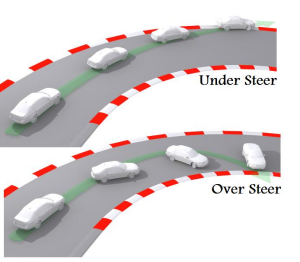 Understeer describes a vehicle's tendency to 'run wide' when steering – requiring extra steering to compensate. In an understeer skid, the car continues in a straight line regardless of where the wheels are pointing. Understeer skids are common in, but not restricted to, front-wheel-drive vehicles. In a front-wheel-drive car, the tyres are trying to provide traction (drive) and steering simultaneously; this can overload them to the point of 'giving up'.
Understeer describes a vehicle's tendency to 'run wide' when steering – requiring extra steering to compensate. In an understeer skid, the car continues in a straight line regardless of where the wheels are pointing. Understeer skids are common in, but not restricted to, front-wheel-drive vehicles. In a front-wheel-drive car, the tyres are trying to provide traction (drive) and steering simultaneously; this can overload them to the point of 'giving up'.
Oversteer occurs mostly in rear-wheel-drive vehicles. The the rear of the car swings out to the outside of the turn – this can result in the vehicle spinning around if it is not corrected. (Front-wheel-drive cars can break free at the rear, but this is less common.)
Recovering from a front wheel (understeer) skid:
Release the gas pedal (power). Steer in the direction of the skid to allow the tyres to regain grip ( on a left bend, steer left; on a right bend, steer right).
Remember that harsh steering can cause problems – too much steering can make matters worse. As the car regains grip, gently steer back on course. Leave the brakes alone – even with ABS you risk overloading the front tyres.
Recovering in a rear wheel (oversteer) skid
Release the gas pedal (power). Steer into the direction of the skid until the rear stops sliding and the tyres regain grip. Steer the car gently back on course, but try not to overreact, or the vehicle may skid in the opposite direction (often referred to as fishtailing). When the tyres regain grip and when safe, gently re-apply the power.
One of the biggest problems in rear wheel skids is over-correction of the steering – this will cause the car to 'fishtail' as the tyres regain grip and slide the other way – it's often this secondary skid that causes the driver to crash.
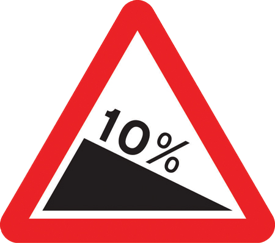 Climbing hills can pose particular problems on slippery roads.
Climbing hills can pose particular problems on slippery roads.
Always leave plenty of space between yourself and the car ahead before starting your ascent. Stop and wait for a clear road if necessary. Otherwise, you may end up being stuck (literally) behind less skilful drivers.
For short hills, you might consider reversing up the hill if you have a front-wheel-drive vehicle - this way, the driving wheels will carry more weight, giving them more grip. Zig-zagging can also help your wheels to grip.
Use low gears to help hold the car back when descending slippery hills. Select the gear as early as possible. (Auto reminder: Use manual mode in an automatic to lock the gear). In electric cars, regenerative braking will help control your speed.
Whatever you drive, aim to avoid using the brakes or changing gear while descending if at all possible, but don't allow the car pick up speed. Be super sensitive when using the footbrake – it can very difficult to regain control in a downhill skid.
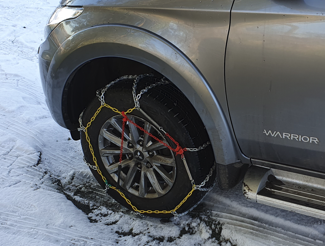 When moving off in snow and ice, use the highest gear possible in a manual car - this will usually be second gear. 'Rock' the car back and forth to get moving (clutch up and down).
When moving off in snow and ice, use the highest gear possible in a manual car - this will usually be second gear. 'Rock' the car back and forth to get moving (clutch up and down).
All cars: If you encounter excessive wheel spin, ease off the gas, otherwise, you will simply 'polish' the snow and ice, making it more slippery.
If you live in a remote rural area (as I do), you might want to invest in snow chains – without mine (see picture), there would be several days every winter when we would be unable to leave our if there was an emergency (even in our 4x4).
Snow socks are an alternative to chains, especially if you mostly make in-town journeys. Snow socks can give the grip to climb hills or help you if you are stuck in a parking space at the side of a road.
Sacks or old door mats under the rear wheels can help the tyres to grip. If you tie them to the 'tow ring', you can pull them behind you until you are on a firmer surface, that way, you won't lose them!
Cat litter or sand is helpful if you get stuck - it can give the traction you need to drive off. The weight of a sack of sand in the back of a rear-wheel drive car would also provide more grip – but you would use more fuel carrying it around.
Don't waste valuable energy trying to get the car free if there is no realistic chance of success, especially if you have run off the road.
This video is a few years old but has an important message!
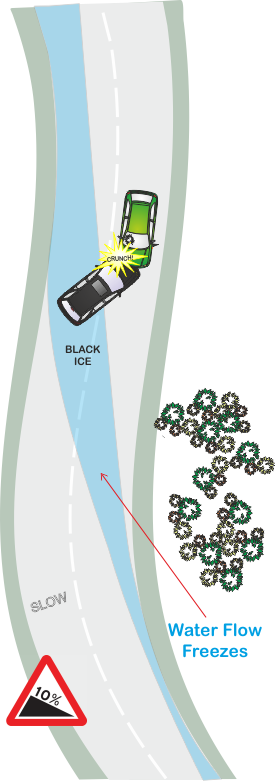 It's easy to be lulled into a false sense of security when sitting in a warm car. But remember that it's freezing out there, so there are likely to be icy patches!
It's easy to be lulled into a false sense of security when sitting in a warm car. But remember that it's freezing out there, so there are likely to be icy patches!
Many cars will display the outside temperature for the driver – you might have to select this display option using a dashboard menu. Keep the display active in winter to remind you about the freezing conditions.
Ice: Unlike snow, ice is not always easy to see. Clues include a lack of 'road noise' and light steering. If you suspect you are on ice, allow plenty of time to stop (remember: up to ten times your average stopping distance).
Ice can be patchy and sometimes only affects the wheels on one side of the car. This is why keeping both hands on the steering wheel is essential so that you are ready to react if the vehicle goes off course. Car stability systems and traction control will help – but they don't do the driving for you!
Water cross fall: When there are bends on hills, water will often run straight across the road. This can be dangerous at any time but becomes lethal when the temperature drops below zero, resulting in an ice sheet across the bend – especially treacherous when travelling downhill. The illustration shows a black car which has lost control and spun across the road. A similar situation can occur on roads with an adverse camber; water can run across and freeze, leaving a skating rink surface.
Snow can be deceptive. Whatever kind of snow you are driving on, you must remember that the car is more likely to go sideways than is normally the case! Often your tyres will have more grip on newly fallen snow than on slushy or compacted snow. It's not always the best policy to follow the wheel tracks of the vehicles ahead.
Gently test your brakes from time to time - this will give you a feel for the surface conditions and available grip.
Shade: Even when the temperature rises above freezing and the roads are wet rather than snowy, take care in places where the winter sun never reaches, for example, under trees, in hollows, under railway bridges, or where high walls or buildings shade the road. The shade can create a mini temperature dip for that stretch of road – there could still be ice.
Overpasses and bridges: We've mentioned that there could be icy patches under railway bridges, but there can also be problems when driving over bridges where cool air passing beneath them keeps the temperature down.
Freezing fog: Freezing fog causes ice 'droplets' in the air. In turn these can form ice on any surface - for example, freezing your wipers onto the windscreen. When there is freezing fog there is likely to be a lot of black-ice about, follow all the winter driving 'rules' in this section.
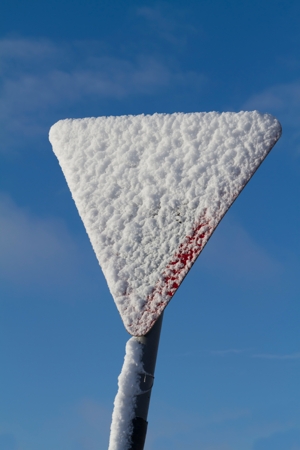 Road signs and markings can be obscured or completely hidden by snow. You might know who has priority at junctions on the roads in your local area, but does the other driver?
Road signs and markings can be obscured or completely hidden by snow. You might know who has priority at junctions on the roads in your local area, but does the other driver?
Even signs that are obliterated by snow can be helpful when driving in strange areas.
Triangular signs warn of danger. Inverted triangles always mean 'Give Way' – octagonal signs mean stop.
Circular signs give positive or negative orders. The location of the sign might provide a clue to its meaning. For example, circular signs on both sides of the road entering a town or village are likely to be speed limits – more often than not, 30 mph.
Your car: Your car gives information to others. In heavy falling snow, switch on your lights – don't rely on the cars' running lights' alone.
In many vehicles, running lights only operate at the front - you don't want to be hit from behind by a driver who sees you too late!
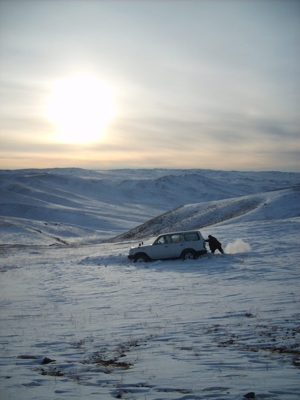 Thankfully, we rarely hear of winter deaths due to people getting stranded in their cars, at least not in the UK. However, you can minimise your risk by keeping a 'winter survival kit' in your car. This is especially important for people who live in rural or remote areas – where you can't always rely on being rescued.
Thankfully, we rarely hear of winter deaths due to people getting stranded in their cars, at least not in the UK. However, you can minimise your risk by keeping a 'winter survival kit' in your car. This is especially important for people who live in rural or remote areas – where you can't always rely on being rescued.
Some roads can be so severely hit by drifting snow that even snowblowers and large mechanical shovels have difficulty clearing them.
A modern reason for becoming stranded is running out of power in an electric vehicle. Electric vehicle batteries will drain quicker in cold weather – reducing the range. These simple tips can help extend the range.
Use heated seats rather than the cabin heater – these heat you directly rather than wasting energy heating the whole cabin.
Use eco mode (this can also reduce the risk of wheel spin)
(If available on your model) Precondition the car while it's plugged in. This warms the vehicle and battery before your winter journey
Park in direct sunlight whenever you can. It won't make a major difference, but it keeps the car and battery warmer and can eke out a few miles of extra range.
In a combustion engine car, it goes without saying that you must always be have enough fuel for your winter journey.
If you get stranded in any vehicle, the most crucial advice is that you are safer inside your car than out. Walking a couple of miles to get home or seek help can be tempting, but in freezing blizzard conditions, this can lead to disaster for anyone who is not fully fit and kitted out with the appropriate winter clothing.
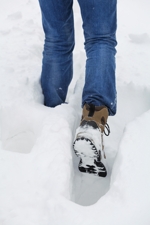 Stay in your vehicle but be careful about keeping the engine running. Only run your engine for about 20 minutes each hour. There is a real danger of fumes filling the car, so you must ensure that there is a clear area for the exhaust fumes to dissipate (you might have to clear snow to do this). In an electric car, be very frugal with the heater – only use it if there is no alternative (life or death situation).
Stay in your vehicle but be careful about keeping the engine running. Only run your engine for about 20 minutes each hour. There is a real danger of fumes filling the car, so you must ensure that there is a clear area for the exhaust fumes to dissipate (you might have to clear snow to do this). In an electric car, be very frugal with the heater – only use it if there is no alternative (life or death situation).
Never leave the vehicle unless you can see your destination close by, and it is no further than 100 metres away (a building or other vehicle).
If you have 'space blankets', use them to cover the windows inside to reflect body heat - most heat is initially lost through the windows.
If you are in a remote area and there is an air search, make your car as visible as possible - clear snow off the roof, fly a fluorescent vest from the aerial or spread it on the roof.
Use your phone regularly to let the emergency services and friends know where you are and that you are OK, and listen to the local radio station for news and weather reports.
This list might seem 'over the top' - but remember that this is about winter survival. You won't need more than a warm coat if you never venture out of town and stay close to home.
But imagine being stuck on a remote back road in the Scottish Highlands - where you could be 'trapped' for 24 hours. Even if you are only a couple of miles from home in a remote rural area, sub zero temperatures and deep snow could leave you stranded for several hours.
The kit:
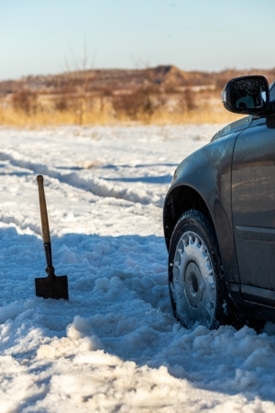
A shovel
Use a hold all or rucksack to keep your winter kit together and pack it with the following essential items.
A couple of blankets or good sleeping bag
A spare, warm coat
A pair of good outdoor boots and warm socks
A hat (a woolly/thermal hat is best)
Warm mittens or gloves
Chocolate bars
Dried fruit and nuts (avoid salted nuts)
At least one bottle of water
Kitchen roll
Torch and batteries
A fluorescent vest or jacket
Medication - if you are on regular medication ensure you have a supply
In addition always ensure that you have a fully charged phone and car charger.
If you live in a remote area like Dartmoor, parts of Wales, the Peak District, the Scottish Highlands etc., it might be worth taking a trip to your local camping store and getting a few extras.
Space blankets
Backpack meals (some are self heating)
At least a gallon of clean drinking water
A small camping gas ring (not for use inside the car)
A plastic or tin mug
Multi-purpose tool (Swiss Army Type)
Hand warmers
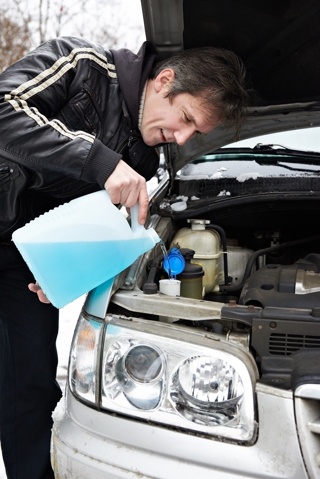 The best way to do this is to get a garage to give your car a health check – but you can do a lot for yourself.
The best way to do this is to get a garage to give your car a health check – but you can do a lot for yourself.
Cooling System: Most cooling systems specify that anti-freeze should be used all year round as a corrosion inhibitor. However, it is a good idea to check the strength of the coolant at the start of the winter. How are your hoses? If your car is more than a couple of years old, check for perished hoses and minor leaks.
Electrics: Most vehicles have electronic ignition, but damp can still cause problems. Ensure all ignition circuit contacts are clean, and spray the system with an ignition sealer (moisture repellent).
Very few batteries need user servicing – the days of topping up the battery acid with distilled water are long gone. But getting your battery checked at the first hint of any problems can save misery on a cold winter morning (or any other time!)
Be kind to your battery in winter by minimising the load placed on it. Don't overuse the starter motor; just use short bursts with long pauses. Switch off all auxiliary equipment when starting the car. Switch off screen de-misters when the windows are clear. In a manual car, press the clutch down before starting the engine to reduce the load on the starter motor.
Air intake: Check to see if your air intake has a winter position; if so, make the appropriate adjustment.
Tyres: Squeezing the last five-hundred miles out of a set of tyres can be counter-productive in winter. You want as much grip as possible when the snow comes (at least 3mm of tread). Plus, changing a tyre in the snow is no fun!
Some tyre companies now offer 'tyre parking'. You can have one set of tyres 'parked' and one set on the car. This makes it more practical to fit winter tires from say, November to March.
Lights: If you drive an older car, it's a good idea to carry a spare set of light bulbs (police patrol officers love to stop vehicles with defective lights). This is probably more important in winter when your lights are getting extra use. Unfortunately, spare bulbs are no longer an option for newer cars because the lights are sealed LED units – some of which need specialist (garage) tools to access and replace (luckily these are a lot more reliable than older vehicle lighting systems).
Make sure you have wash leathers or rags to keep your lights clean in the winter (snow can build up around lights, check to ensure that they are clear and clean as often as possible).
Brakes: It might seem obvious to state that brakes should be in good order, but your wheels will lock earlier on ice than in other situations, and even the slightest mechanical problems can cause skids in winter.
Windscreen washers: These are less likely to freeze up if the system is clean. Make sure you have winter screen-wash; this is less likely to freeze. Keep a supply of screen-wash in the car; driving with an empty reservoir is illegal.
Never use engine anti-freeze in screen washers. Apart from smearing your screen, it may well strip your paintwork!
Wiper blades: These will have to work harder in winter, so make sure that they are in good condition (well-used wiper blades rarely last more than two winters months in the UK climate).